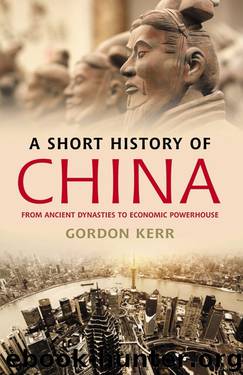A Short History of China by Gordon Kerr

Author:Gordon Kerr [Kerr, Gordon]
Language: eng
Format: epub
ISBN: 9781842439692
Publisher: Pocket Essentials
Published: 2013-01-07T14:00:00+00:00
Expansion
The traditional area of the Middle Kingdom was extended by the Ming Dynasty rulers. The territories of Yunnan and Guizhou were fully subsumed by the empire in 1381. 200,000 colonists flooded into the area and further influxes during the fifteenth and sixteenth centuries brought another 500,000 settlers. Naturally, this brought a change to the ethnic make-up of the region which was populated by only around three million people in the mid-fourteenth century and only around half of those are thought to have been Han. Migrants came from all over China, but they were united by the knowledge that, although they may have spoken with different dialects and enjoyed different customs and traditions, they were Han Chinese.
In such areas as the southwest, where there was a large Chinese population, taxes were collected and the law was enforced by regular officials, but where indigenous tribes were in the majority, the Ming recognised the traditional rights of hereditary rulers to govern their territories in return for tribute payments and for supporting the government when problems arose. Manchuria was also colonised and populated by settlers and, in the northwest, the Ming established control of Hami, the first station on the Old Silk Road, although that was as far as they went into Central Asia.
The Mongols remained a threat in the north and, in the fourteenth century, to protect the country against them, the Ming revisited the notion of the Great Wall. It became even more pressing after their defeat at the hands of the Oirats, the westernmost group of Mongols, at the Battle of Tumu in 1449. The constant incursions from Mongolia and Manchuria were costly and, to protect the empire, frontier walls were constructed along the northern border. The Ming construction was of bricks and stone, unlike the earlier effort of the Qin who used compacted earth. There were up to 25,000 watchtowers and, over the years, the Ming devoted considerable resources to the repair and reinforcement of the Wall.
These movements and displacements of peoples did not take place without problems. Often Chinese settlers would treat the native peoples of the areas in which they had settled as little more than slaves and the resentful locals would terrorise the Chinese whenever they could. Between 1464 and 1466 there were attacks on heavily populated cities by Miao and Yao tribes. The army was sent in to pacify the areas and to execute the leaders of the uprisings, 800 of whom were beheaded in Beijing.
The familiar superior attitude of the Chinese towards other nations was displayed by the tribute system established by Hongwu. He sent out envoys with a manifesto that said:
Download
This site does not store any files on its server. We only index and link to content provided by other sites. Please contact the content providers to delete copyright contents if any and email us, we'll remove relevant links or contents immediately.
| Central Asia | Southeast Asia |
| China | Hong Kong |
| India | Japan |
| Korea | Pakistan |
| Philippines | Russia |
The Sympathizer by Viet Thanh Nguyen(4269)
The Rape of Nanking by Iris Chang(4108)
World without end by Ken Follett(3402)
Ants Among Elephants by Sujatha Gidla(3369)
Blood and Sand by Alex Von Tunzelmann(3106)
Japanese Design by Patricia J. Graham(3085)
City of Djinns: a year in Delhi by William Dalrymple(2491)
The Queen of Nothing by Holly Black(2446)
Foreign Devils on the Silk Road: The Search for the Lost Treasures of Central Asia by Peter Hopkirk(2412)
Inglorious Empire by Shashi Tharoor(2380)
India's Ancient Past by R.S. Sharma(2371)
Tokyo by Rob Goss(2348)
In Order to Live: A North Korean Girl's Journey to Freedom by Yeonmi Park(2321)
Tokyo Geek's Guide: Manga, Anime, Gaming, Cosplay, Toys, Idols & More - The Ultimate Guide to Japan's Otaku Culture by Simone Gianni(2298)
India's biggest cover-up by Dhar Anuj(2287)
The Great Game: On Secret Service in High Asia by Peter Hopkirk(2265)
Goodbye Madame Butterfly(2182)
Batik by Rudolf Smend(2063)
Living Silence in Burma by Christina Fink(2016)
